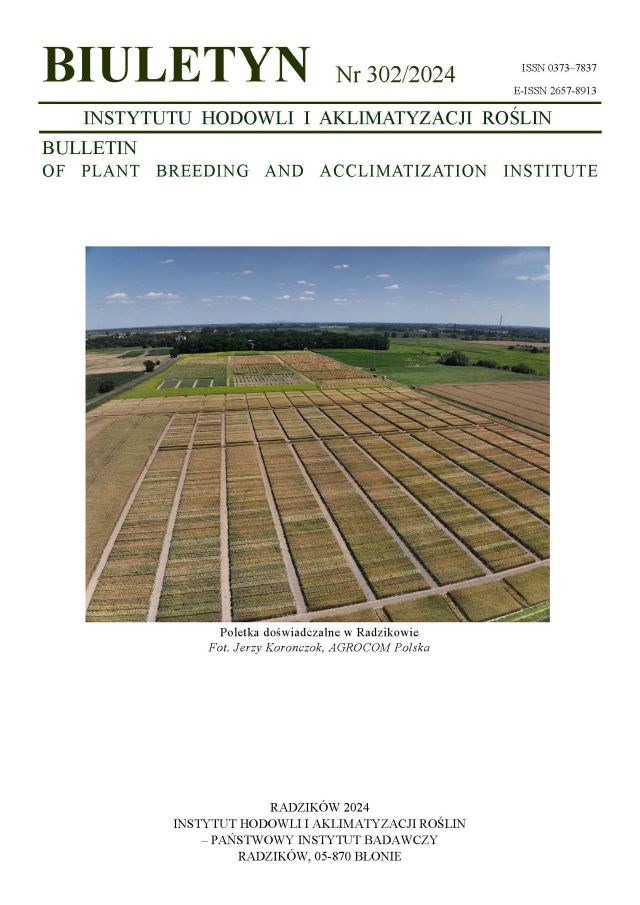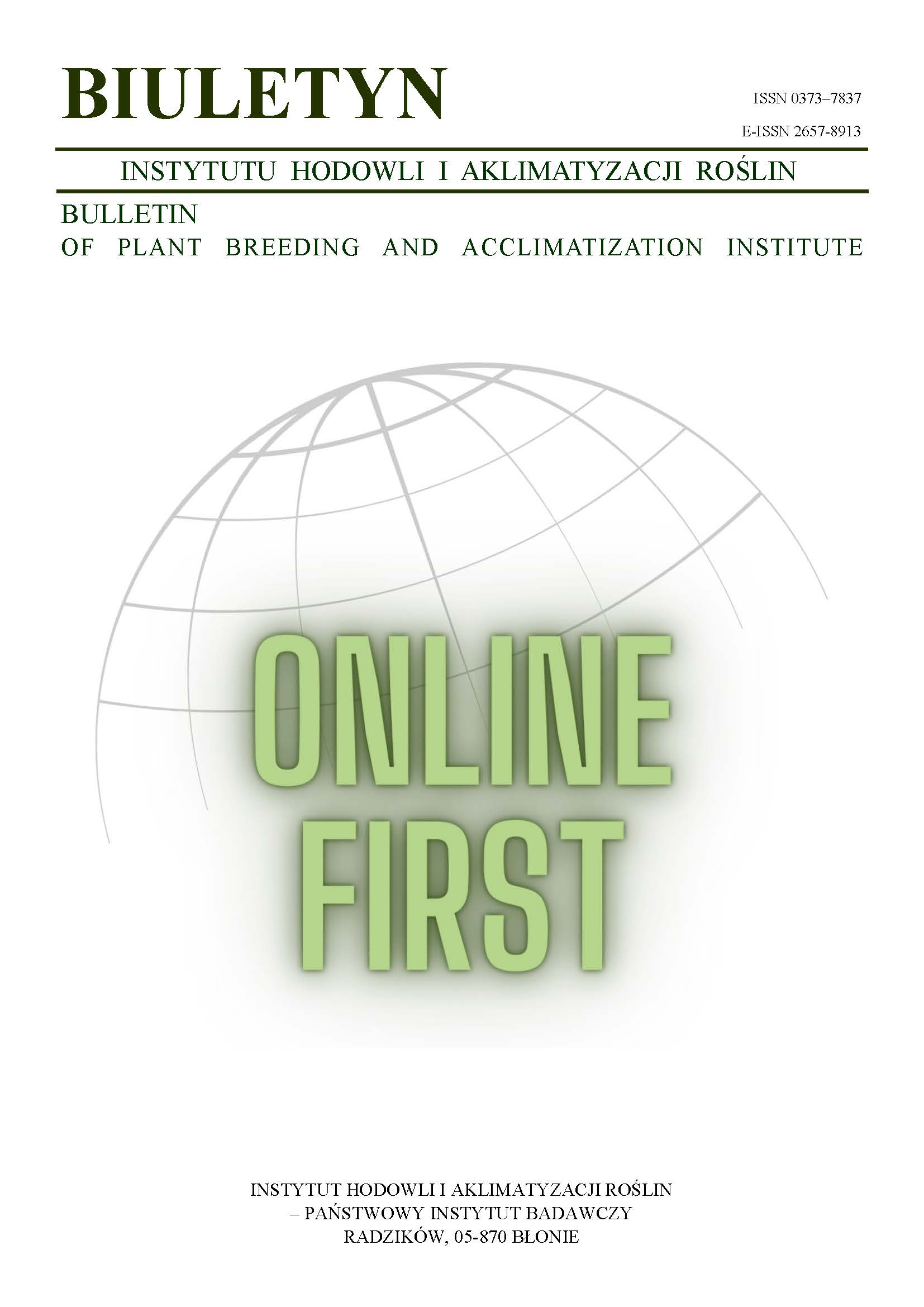Estimation of the interrelationships between different traits of winter wheat using the path analysis
Tadeusz Śmiałowski
zhsmialo@cyf-kr.edu.plInstytut Hodowli i Aklimatyzacji Roślin, Kraków (Poland)
Zygmunt Nita
Hodowla Roślin Strzelce Sp. z o.o. (Poland)
Edward Witkowski
Hodowla Roślin Smolice Sp. z o.o. (Poland)
Abstract
The aim of the work was to estimate variability, genetic differentiation and correlation between 19 traits in 112 strains of the winter wheat grown in 2004 in a preliminary trial in 7 localities. The estima-tion was performed both in the field and under laboratory conditions. The following traits were evaluat-ed: grain yield, winter hardiness, earliness (days to heading), time to maturity (days), height of plants, canopy uniformity, weight of 1000 grains, sedimentation value, wet gluten and protein contents, as well as resistance to lodging and preharvest sprouting, and that to infection with: powdery mildew, brown rust, yellow rust, stem rust, leaf septoria, ear septoria and head blight (Fusarium culmorum). The coef-ficients of variability (CV) for the investigated traits varied from high for the value of sedimentation (29%) to low for the resistance to stem rust (1.7%) and for the time to maturity (2.5%). The coefficients of genetic differentiation (h2) were high for all the traits, except for the resistance to ear septoria. In most cases, the coefficients of correlation between the analysed traits were low. Statistically significant corre-lation between grain yield and the following traits: resistance to ear septoria (0.230*), gluten content (-0.232*), protein content (-0.239*), plants height (0.232*) and lodging (0.190*), was recorded. The path analysis was used to estimate interrelationships between grain yield and the following traits: winter har-diness, time to heading, time to maturity, plants height, weight of 1000 grains, resistance to preharvest sprouting, and resistance to leaf septoria. Statistically significant direct effects of plants height and win-ter wheat resistance to leaf septoria upon grain yield were found (0.393** in both cases). The effect of the time of maturity on grain yield was highly significant but negative (-0.371**). This surprising effect was masked by a relatively strong (0.244) indirect effect of leaves infestation by septoria. The coeffi-cients of correlation between grain yield and protein and wet gluten contents were low (-0.232* and –0.239*, respectively). Highly significant direct relationships between the grain yield and both the protein content and the sedimentation value, were revealed (-0.341** and 0.336**, respectively), despite the low correlation between these traits.
Keywords:
agricultural and technological traits, path analysis, winter wheatReferences
Akanda S. I., Mundt. C. C. 1996. Path coefficient analysis of the effects of stripe rust and cultivar mixtures on yield and yield components of winter wheat. Theor. Apel. Gen. 92/8: 666 — 672.
DOI: https://doi.org/10.1007/BF00226087
Google Scholar
Bichoński. A. 1995. Cechy technologiczne wybranych krajowych i zachodnioeuropejskich form pszenicy ozi-mej. Biul. IHAR 193: 19 — 28.
Google Scholar
Cygankiewicz A. 1995. Ocena niektórych cech jakościowych nowych rodów hodowlanych pszenicy ozimej i jarej. Biul. IHAR 194: 139 — 147.
Google Scholar
Cygankiewicz A. 1997. Skuteczność wstępnej oceny ziarna rodów i odmian wzorcowych pszenicy w oparciu o wartość liczby sedymentacji i procentowej zawartości białka w porównaniu do wartości współczyn¬ników pełnej oceny. Biul. IHAR 204: 237 — 243.
Google Scholar
Deczev. D. 1990. Path analysis of yield components in durum wheat. Genetica i Selekcija 23: 213 — 216.
Google Scholar
Dewey D. R., Lu K. H. 1959. A correlation and path-coefficient analysis of components of creased wheatgrass seed production. Agron. J.: 515 — 517.
DOI: https://doi.org/10.2134/agronj1959.00021962005100090002x
Google Scholar
Donaldson E., Schillinger, Dofing S. M. 2001. Straw production and grain yield relationships in winter wheat. Yield Sci. 41: 100 — 106.
DOI: https://doi.org/10.2135/cropsci2001.411100x
Google Scholar
Drzazga T. 2000. Zastosowanie analizy współczynników ścieżek dla ocen wpływu komponentów plonu psze-nicy jarej. Biul. IHAR 216 /2/: 329 — 323.
Google Scholar
Garcia M., Rharrabti D., Villegas C. R., Royo C. 2003. Evaluation of grain yield and its components in durum wheat under Mediterranean conditions. Agron. J. 95: 266 — 274.
DOI: https://doi.org/10.2134/agronj2003.2660
Google Scholar
Kadłubiec W., Jedyński S., Lonc W., Strugała J. 1989. Analiza ścieżek Wrighta komponentów plonu linii i mieszańców F1 pszenicy ozimej. PNR 382: 127 — 132
Google Scholar
Ługowska B., Banaszak Z., Wójcik. W., Grzmil W. 2004. Zależność plonu ziarna pszenicy ozimej o skróconym źdźble od jego składowych. Biul. IHAR 231: 5 — 10.
Google Scholar
Paroda R. S., Joshi. A. B., Slanki K. R. 1974. Path, coefficient analysis for ear characters in Wheat. Cereal Research Comm. 2: 77 — 84.
Google Scholar
Pochaba L., Węgrzyn S. 2000. Zmienność i współzależność kilku cech pszenicy ozimej. Biul. IHAR 216/2/: 261 — 272.
Google Scholar
Sidwell. R. J., Smith E. L., McNew R. W. 1976. Inheritance and interrelationships of grain yield and selected yield-related traits in a Hard Red Winter Wheat cross. Yield Sci. 16: 650 — 654.
DOI: https://doi.org/10.2135/cropsci1976.0011183X001600050013x
Google Scholar
Singh D., Singh M., Sharma K. C. 1977. Correlations and path coefficient analysis among flag area yield and yield attributes in wheat. Cereal Research Comm. 7: 145 — 152.
Google Scholar
Węgrzyn S. 1989. Możliwości wykorzystania genetyki ilościowej w hodowli roślin. Biul. IHAR 171/172: 135 — 142.
Google Scholar
Węgrzyn S., Wojas T., Śmiałowski T. 2002. Zróżnicowania genetyczne oraz współzależność plonu i wybranych cech użytkowych pszenicy ozimej (Triticum aestivum L.). Biul. IHAR 223/224: 77 — 86.
Google Scholar
Authors
Tadeusz Śmiałowskizhsmialo@cyf-kr.edu.pl
Instytut Hodowli i Aklimatyzacji Roślin, Kraków Poland
Authors
Zygmunt NitaHodowla Roślin Strzelce Sp. z o.o. Poland
Authors
Edward WitkowskiHodowla Roślin Smolice Sp. z o.o. Poland
Statistics
Abstract views: 28PDF downloads: 6
License
Copyright (c) 2006 Tadeusz Śmiałowski, Zygmunt Nita, Edward Witkowski

This work is licensed under a Creative Commons Attribution-ShareAlike 4.0 International License.
Upon submitting the article, the Authors grant the Publisher a non-exclusive and free license to use the article for an indefinite period of time throughout the world in the following fields of use:
- Production and reproduction of copies of the article using a specific technique, including printing and digital technology.
- Placing on the market, lending or renting the original or copies of the article.
- Public performance, exhibition, display, reproduction, broadcasting and re-broadcasting, as well as making the article publicly available in such a way that everyone can access it at a place and time of their choice.
- Including the article in a collective work.
- Uploading an article in electronic form to electronic platforms or otherwise introducing an article in electronic form to the Internet or other network.
- Dissemination of the article in electronic form on the Internet or other network, in collective work as well as independently.
- Making the article available in an electronic version in such a way that everyone can access it at a place and time of their choice, in particular via the Internet.
Authors by sending a request for publication:
- They consent to the publication of the article in the journal,
- They agree to give the publication a DOI (Digital Object Identifier),
- They undertake to comply with the publishing house's code of ethics in accordance with the guidelines of the Committee on Publication Ethics (COPE), (http://ihar.edu.pl/biblioteka_i_wydawnictwa.php),
- They consent to the articles being made available in electronic form under the CC BY-SA 4.0 license, in open access,
- They agree to send article metadata to commercial and non-commercial journal indexing databases.
Most read articles by the same author(s)
- Tomasz Góral, Halina Wiśniewska, Piotr Ochodzki, Dorota Walentyn-Góral, Iga Grzeszczak, Jolanta Belter, Maciej Majka, Jerzy Bogacki, Tadeusz Drzazga, Bogusława Ługowska, Przemysław Matysik, Edward Witkowski, Krzysztof Rubrycki, Urszula Woźna-Pawlak, Fuzarioza kłosów oraz akumulacja toksyn fuzaryjnych w ziarnie rodów hodowlanych pszenicy ozimej , Bulletin of Plant Breeding and Acclimatization Institute: No. 282 (2017): Regular issue
- Piotr Stefański, Patrycja Siedlarz, Przemysław Matysik, Zygmunt Nita, Krystyna Rybka, The usefulness of light sources based on diodes characterized by a continuous spectrum of white light enriched with a blue band in cereal breeding , Bulletin of Plant Breeding and Acclimatization Institute: No. 284 (2018): Regular issue
- Maciej Majka, Magdalena Gawłowska, Adriana Twardawska, Marek Korbas, Jakub Danielewicz, Tomasz Góral, Bogusława Ługowska, Jolanta Belter, Edward Witkowski, Tadeusz Drzazga, Przemysław Matysik, Urszula Woźna-Pawlak, Halina Wiśniewska, Use of molecular and phenotypic markers to identify wheat eyespot resistance genes caused by Oculimacula yallundae and O. acuformis , Bulletin of Plant Breeding and Acclimatization Institute: No. 288 (2020): Regular issue
- Joanna Ukalska, Krzysztof Ukalski, Tadeusz Śmiałowski, Wiesław Mądry, An examination of diversity and interrelationships among traits in a winter wheat (Triticum aestivum L.) germplasm collection by multivariate methods. Part II. Principal component analysis using the phenotypic and genotypic correlation matrix , Bulletin of Plant Breeding and Acclimatization Institute: No. 249 (2008): Regular issue
- Krzysztof Ukalski, Joanna Ukalska, Tadeusz Śmiałowski, Wiesław Mądry, An examination of diversity and interrelationships among traits in a winter wheat (Triticum aestivum L.) germplasm collection by multivariate methods. Part I. Phenotypic and genotypic correlations , Bulletin of Plant Breeding and Acclimatization Institute: No. 249 (2008): Regular issue
- Przemysław Matysik, Zygmunt Nita, Ewelina Matysik, Effectiveness of selection criteria applied in F4 progeny of winter wheat on the basis of yield components , Bulletin of Plant Breeding and Acclimatization Institute: No. 244 (2007): Regular issue
- Marcin Studnicki, Wiesław Mądry, Tadeusz Śmiałowski, Multivariate analysis of phenotypic diversity in Polish spring wheat collection , Bulletin of Plant Breeding and Acclimatization Institute: No. 252 (2009): Regular issue
- Tadeusz Śmiałowski, Stanisław Węgrzyn, Maria Stachowicz, Variation and correlation analysis of important technological traits of winter wheat cultivars and strains , Bulletin of Plant Breeding and Acclimatization Institute: No. 249 (2008): Regular issue
- Tadeusz Drzazga, Paweł Krajewski, Tadeusz Śmiałowski, Ewa Śmiałek, Drought resistance assessment of winter wheat cultivars , Bulletin of Plant Breeding and Acclimatization Institute: No. 260/261 (2011): Regular issue
- Mirosław Tyrka , Grzegorz Fic , Magdalena Szeliga , Marcin Jaromin , Paweł Krajewski , Paweł Milczarski , Tadeusz Drzazga , Przemysław Matysik , Róża Mazur , Teresa Sikora , Edward Witkowski , Justyna Buczkowicz , Dorota Tyrka , Genomic selection of winter wheat , Bulletin of Plant Breeding and Acclimatization Institute: No. 286 (2019): Special issue














